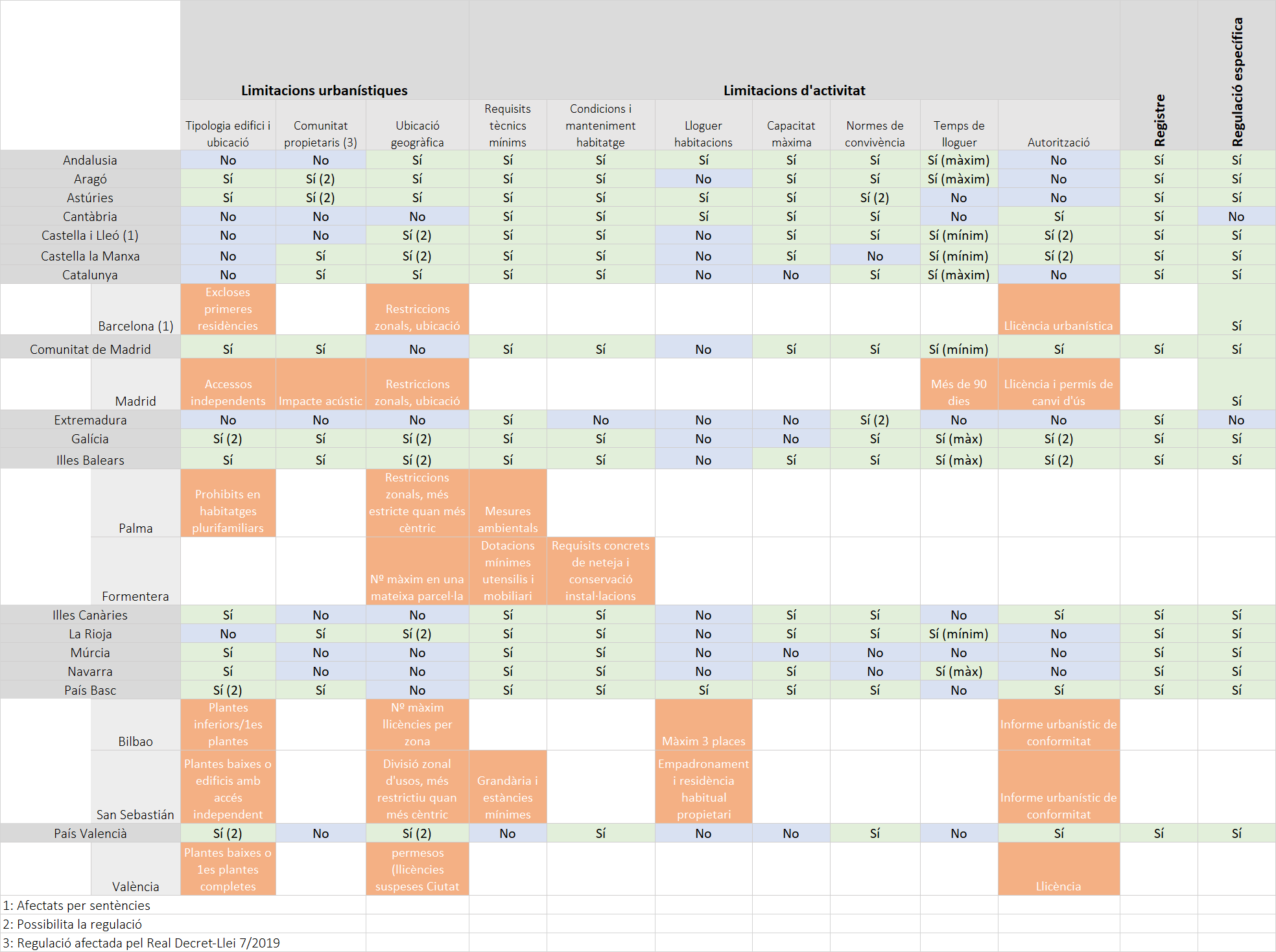The analysis of autonomous and municipal regulation of tourist dwellings presented below attempts to summarise in broad strokes and visually represent the main elements of coincidence and difference in the regulation between the different regions of Spain. To this end, we have provided a summary table, which can be consulted at the bottom of this page, as well as a document with more detailed tables, with the linked regulation, available for download. For the organisation of the information, the creation of 4 different categories has been considered appropriate:
- Specific Regulation
- Urban planning constraints
- Activity limitations
- Autonomous activity register
The following is a brief summary of the main conclusions drawn.
Specific regulation
Although there are some differences in nomenclature, most Autonomous Communities use the concept of “housing for tourist use”. In addition, almost all of them are distinguished from tourist flats, which, in turn, also implies that different conditions and limitations are established.
Urban planning constraints
This section includes those provisions that aim to regulate the physical location of housing, their density by zones or even to establish a definition of the type of buildings that can be used as tourist housing.
Building type and location
It is common for Autonomous Communities to establish building characteristics that housing for tourist use has to comply with. In Aragon, for example, only properties subject to the horizontal property regime, detached single-family dwellings or other properties belonging to private real estate complexes may be considered as such. As for the cities, they add requirements for the establishment of tourist activity in housing, among which the prohibition of locating tourist housing above residential use stands out.
Community of owners
Most of the regulations, prior to Royal Decree Law 7/2019, already mentioned the community of neighbours as an actor with the capacity to limit or prohibit the existence of tourist housing in buildings affected by the horizontal property regime. In these cases, the owners or managers of housing for tourism purposes will have to accredit, together with the responsible declaration, that this activity is permitted or is not expressly prohibited by the statutes of the community of owners.
Geographic location
As regards the geographic location where the establishment of this type of tourist accommodation is allowed, approximately half of the regions mention some type of limitation. Likewise, the most recent regulations include the forecast of saturated tourist areas or zones, in order to take into account the density of tourist use in each area when permitting new facilities. Additionally, in some cases, regional legislation allows municipalities to establish limits in this area, without expressly regulating them. In cities such as Madrid, Barcelona, Palma, Bilbao or San Sebastián, this has translated into the design of zoning plans applied in their general urban development plans, which are more restrictive the more central the neighbourhoods are.
Activity limitations
Practically all the autonomous communities have decrees implementing their respective tourism laws which establish the minimum requirements that housing must meet in order to carry out their activities.
Minimum technical requirements
Within this category, there are requirements related to habitability conditions, for example, access to continuous electricity and water services, the size of rooms, minimum furniture or other requirements, such as air conditioning, soundproofing, among others. More generally, and referring to sectoral regulations, accessibility and safety issues and, more exceptionally, environmental sustainability are often mentioned. The level of detail on these issues varies greatly depending on the regulation.
Maximum capacity
Practically all the autonomous communities regulate the maximum capacity that dwellings can accommodate. In some cases, this will be determined by what is set out in the occupancy licence, while other regulations set ratios.
Maintenance and cleaning
This category refers to issues related to the state of conservation, maintenance and hygiene of the properties, so that the housing for tourist use are always in the proper conditions for their use. With the exception of Extremadura, all regulations determine requirements in this area, with a great variation in the level of detail.
Allowed rental period
The Autonomous Communities regulate the rental period for tourist housing in very different ways. Thus, depending on whether it is considered to be a more or less professionalised activity, the different regions have chosen to set the maximum or minimum time allowed to consider it to be tourist housing. This divergence is related to the exclusivity of the tourist use of housing, which is not provided for in all regions.
Rules for living together
On the subject of the rules for living together, they usually appear among the obligations of the users. In some decrees, non-compliance will be grounds for expulsion, as is the case in Cantabria.
Assignment for stays/Rental by rooms.
It is rare for room rentals to be allowed, most regulations tend to make express reference to the need to rent the units as a whole. However, this does not always mean that it is prohibited, but that it will not be considered a tourist rental, as is the case in La Rioja.
Authorisation
Most Autonomous Communities allow the establishment of authorisations for the start of activity, although very few regulate it as a prerequisite. This implies that the option is given for them to be established at a later date, either through autonomous or municipal regulation.
Autonomous activity register
All the Autonomous Communities regulate the obligation to register tourist housing in the Register. However, it is not always specified whether there will be a specific section on Housing for Tourist Use.



